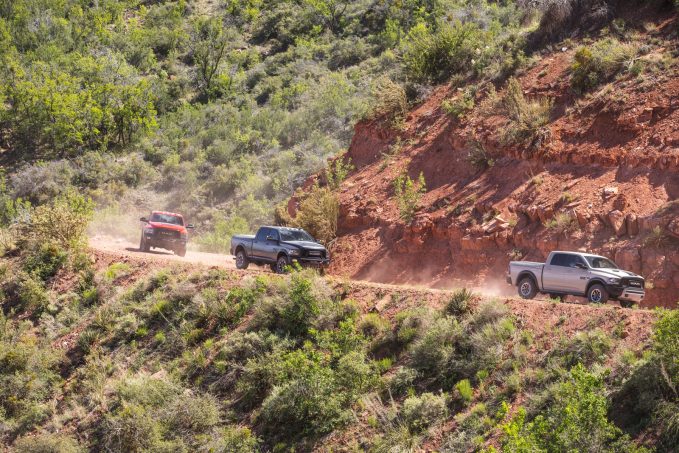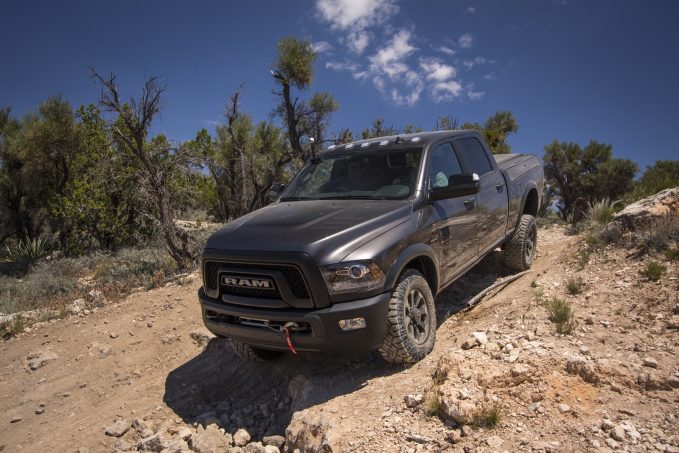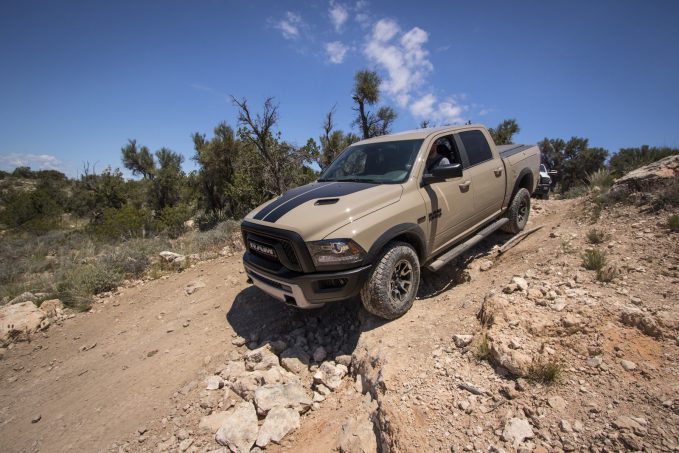It’s easy to mistakenly write off a truck like the 2017 Ram 1500 Rebel as overrated when it comes to off-road prowess.
That’s particularly true when one is parked amongst a herd of hulking Ram 2500 Power Wagons. After all, the Power Wagon is the be-all and end-all of trail-tackling trucks on the market, something .com’s truck expert Stephen Elmer recently rediscovered at the launch of the refreshed 2017 version. Its ability to climb over rather than around obstacles is virtually unmatched by anything this side of a Jeep Wrangler Rubicon.
By contrast, the Rebel can at first glance look like little more than an appearance package that’s been added to Ram’s half-ton truck — and that’s because it mostly is. Except if you dig a little deeper, you’ll find a pickup that’s packed with potential. Bilstein shocks at all four corners compliment a standard air suspension setup that gets an extra inch of ground clearance, while the limited-slip rear differential helps cut wheel spin in low-traction situations.
ALSO SEE: 2017 Ram 2500 Power Wagon Review
Even some of the stuff that makes up its rugged appearance — the front bumper complete with massive skid plate, for example — helps enhance the Rebel’s abilities on the trail. And that’s why, when faced with the choice of piloting a Power Wagon or running a Rebel through the desert, I chose the Rebel.
Why the Rebel?
Coinciding with this year’s Overland Expo West in Flagstaff, Ariz., I was able to test some of Ram’s products in the heart of the Copper State. An event like this would be no picnic, and I was excited. It would provide a unique opportunity to put the brand’s trucks through their paces in a punishing environment.
Hot on the heels of the launch of the refreshed Power Wagon, there’s little left for that pickup to prove. Packed to the gills with off-road goodies, there are few challenges the Power Wagon can’t handle with ease. As .com’s resident truck-whisperer, Stephen Elmer, wrote of the 2017 version, the Power Wagon packs “the capability of a heavy-duty with the climbing ability of a mountain goat.” ‘Nuff said.
Instead, it was the Ram Rebel that piqued my interest, a truck that, while looking every bit the part of an off-road extraordinaire, isn’t on the same level as its big brother. It’s a bit of a daunting task to try to keep up with a pack of off-road-ready rigs like the Power Wagon, and one that looks that much more ominous behind the wheel of the comparatively puny Ram Rebel.
Even with the air suspension set to its tallest height, at 10.3 inches (262 millimeters), the Rebel stands significantly shorter than the Power Wagon’s 14.3 inches (363 mm). Its independent front suspension that boasts far less articulation, let alone resistance to damage, certainly wasn’t making the case for the Rebel’s success any stronger as we departed Flagstaff on the journey to rougher pastures.
All the Right Stuff
It’s not as if the Ram Rebel is ill-equipped for some time on the trail — it includes its fair share of standard and available features that make it a match for the matter at hand. The abbreviated front bumper provides a commendable 25.3-degree approach angle while also featuring a massive pre-runner-style skid plate.
For some added protection, front suspension and transfer case skid plates can be added for a nominal fee — and indeed were added to the two Rebels running in our group of 10 trucks. Our truck also featured a pair of black tubular side steps that, while nowhere near as tough as a set of rock sliders, provided an extra line of defense against damage to the rocker panels.
Also along for the ride was the optional 5.7-liter Hemi V8 engine that added weight to the truck’s front end but brought with it a prerequisite amount of power for getting out of jams both off the beaten path and out on the pavement. Relaying that extra power to the ground through all four wheels was a set of factory-fitted 33-inch Toyo Open Country tires that boast an aggressive tread designed for life in the desert.
In Hot Pursuit
Turning off the highway, the tires were aired down to 40 psi for a wider track and improved traction out on the rough stuff. With the transfer case set to 4WD-high, we took up position at the back of the pack, ready to pursue the Power Wagons on our journey towards House Mountain.
The Jeep-friendly trails proved a touch too narrow for our trucks, but never too challenging for the Rebel. Negotiating basketball-sized boulders and dropping off three-foot ledges proved anything but problematic, the truck handling such rocky outcroppings with ease in 4WD-low. Even without the Power Wagon’s locking differentials and disconnecting sway bar, never was there an obstacle that the truck got hung up on as we worked our way towards the summit. In fact, it was only the low-hanging side steps that finished the day a little scraped up, though the rocker panels themselves were never at risk.
ALSO SEE: 2017 Chevrolet Colorado ZR2 Review
The way back down saw us missing the hill descent control feature found in the Power Wagon, though it was a problem that was easily solved by using the transmission’s manual mode to employ engine braking.
The Verdict: Can a Ram Rebel Keep up with a Power Wagon?
The return trip took us along a (relatively) high-speed service road filled with plenty of switchbacks and blind corners. And it was here that the Ram Rebel proved superior to its Power Wagon counterpart, offering a lighter and nimbler and, best of all, smoother ride. The Rebel may not be a purebred trail truck, but it still packs enough off-road ability to make chasing down its big brother a breeze without impacting its on-road manners.











